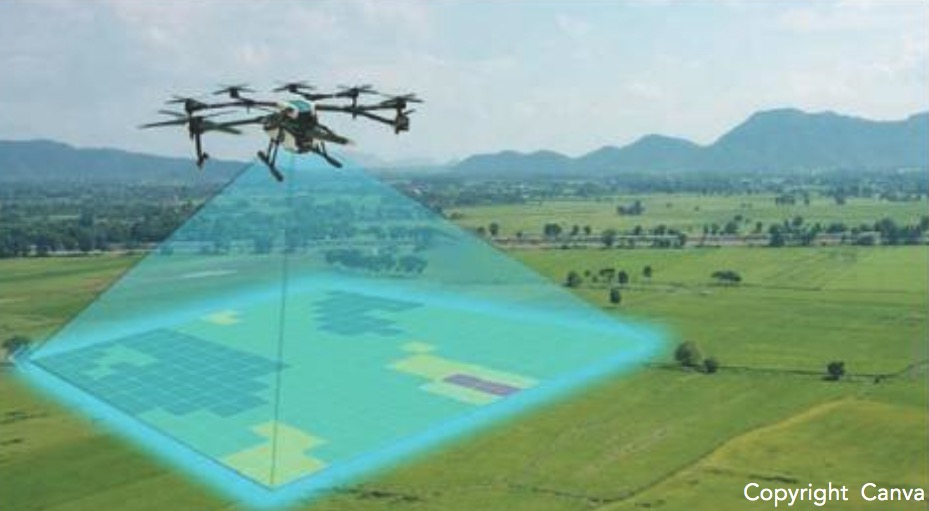SURESH RAMPHUL
Filmmakers find that shooting with drones is cheaper than shooting with helicopters. Drones provide clear and stunning images captured from a height. They are effective in close-ups. TIME magazine writes that in Martin Scorsese’s “The Wolf of Wall Street”, “drones were used to shoot a raucous party scene from above, allowing audiences to peer voyeuristically into characters’ lives”. We now know that in “Jurassic World” (2015) drones were used to imitate the frantic movements of flying reptiles as they were attacking people. Drones have added a new dimension to cinematography, giving scenes in movies a spectacular and exciting touch. 
In Myanmar deforestation was devastating mangroves. These needed to be saved. Nearly 3 million mangroves were to be planted but this was time-consuming. They found that drones could plant trees (by shooting seeds into the water) 10 times faster and costs could be cut by half. To capture the damage caused in Haiti in 2010 by an earthquake, the International Organisation for Migration used drones. These were not only used in reconstruction efforts after typhoon Haiyan hit Philippines in 2013 but were also used to discover where farmland was most at risk from natural disasters, and to assess the impact.
Storm damage
Drones are efficient in mapping flood and storm damage. Unmanned Aerial Vehicles or drones capture photographs and videos accurately. They are used in aerial surveys in the aftermath of cyclones and catastrophes. They provide 3D maps that are said to be often more detailed than satellite imagery. Information gathered by drones has proved to be crucial to rescuers on disaster sites.
Drones transport medicines or food to inaccessible regions. During COVID-19 they were used in several countries to deliver personal protective equipment. In 2014 Médecins Sans Frontières made ample use of drones to deliver vaccines and first-aid supplies in Papua New Guinea. Saudi Arabia was affected in 2009 by flash floods. It was decided to try drones as part of a new flash flood alert system.
Drones are used for military purposes. Intelligence personnel study the information received on the battlefield through drones to determine their line of attack or defence. In 2020 Turkey used drones to attack forces in Syria. Drones give indications on enemy position apart from scouting artillery. In the 2022 Russian invasion of Ukraine, extensive use of drones was made. Drones can carry missiles or bombs. Today drones are acknowledged as a powerful weapon.
It is difficult to monitor vast container terminals. But drones can make the task easier. They help Customs in some countries to take razor-sharp images from great distance at night or during the day. Drones are useful in the fight against drug smuggling or against drug gatherers (those who remove drugs from containers). E-commerce is common today. Companies are resorting to drones in last mile delivery or the last steps in the movement of goods from a transporting hub to the buyer’s doorstep. Delivery becomes easier, quicker and there is customer satisfaction. Drones help in crop monitoring and planting seeds. They spray pesticides and provide data about the state of the crops and the soil. Thus they assist in the improvement of the soil and the crops. Otherwise the planters would incur heavy losses.
Terrorism
In “Drones and Terrorism – Asymmetrical Warfare and the Threat to Global Security”, Nicholas Grossman writes: “Some large American drones carry super-powered cameras that can monitor everything in a 100-square kilometer area, automatically tracking suspects’ vehicles 20,000 feet below. In Afghanistan, British soldiers used a micro drone called the Black Hornet, a tiny helicopter that looks like a toy but costs $200,000 to fly around corners, over hills, and into buildings, warning them of ambushes. These informational capabilities help counterinsurgents protect large areas, identify enemies, and avoid civilian casualties.” Terrorists and insurgents tend to use cheaper varieties. “In a 2006 war against Israel, Hezbollah used Iran-built drones to monitor Israel troops as they advanced into southern Lebanon.”
How do you keep a watch on wildlife? Researchers have come up with the idea of using taxidermy bird parts with flapping drone mechanisms to mimic the appearance and actions of living birds. In sports events, sophisticated cameras in drones help to monitor crowds, identify untoward incidents or trouble makers, and to collect evidence. They are a boon to broadcasters, who can now capture the action better as drones provide mind-blowing angles.
In cases of oil spills, drones have demonstrated quicker response. A slow response means the oil will spread fast. Drones can be deployed at short notice and operate on a 24/7 basis. Even in the darkness, they perform well. Oil spills pose serious threats to humans and marine life. Thanks to drones, oil spill management becomes easier. On the other hand, embers from the main forest fire can easily be carried by the wind. New fires can be provoked. Fire fighters can today use drones to scan large areas quickly. Drones make it possible for them to see through smoke and they can be used at night. They can then take the necessary steps to mitigate the impact of the fires. Drones could be an additional means to combat illegal fishing activities. Billions of dollars are lost every year. This technology can stay at sea for hours and cover vast areas; they can monitor and record data about a boat’s location and its identification. And they are affordable.
However, it’s good to remember that drones were never made to encroach upon any individual’s privacy or to drop illegal materials in prison yards, or to transport drugs across the oceans. Today narco-drones are gaining more and more popularity in certain parts of the world. Cartels are using them for criminal purposes: drones kill rival gangs or anti-narcotics officers in surprise attacks by releasing home-made bombs or grenades.


